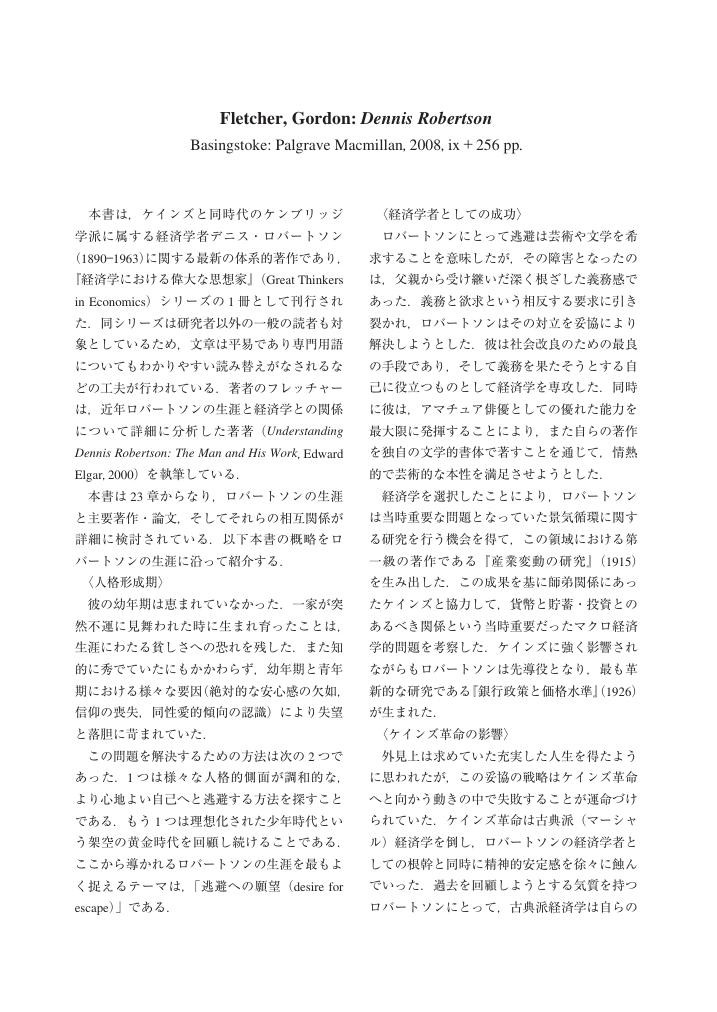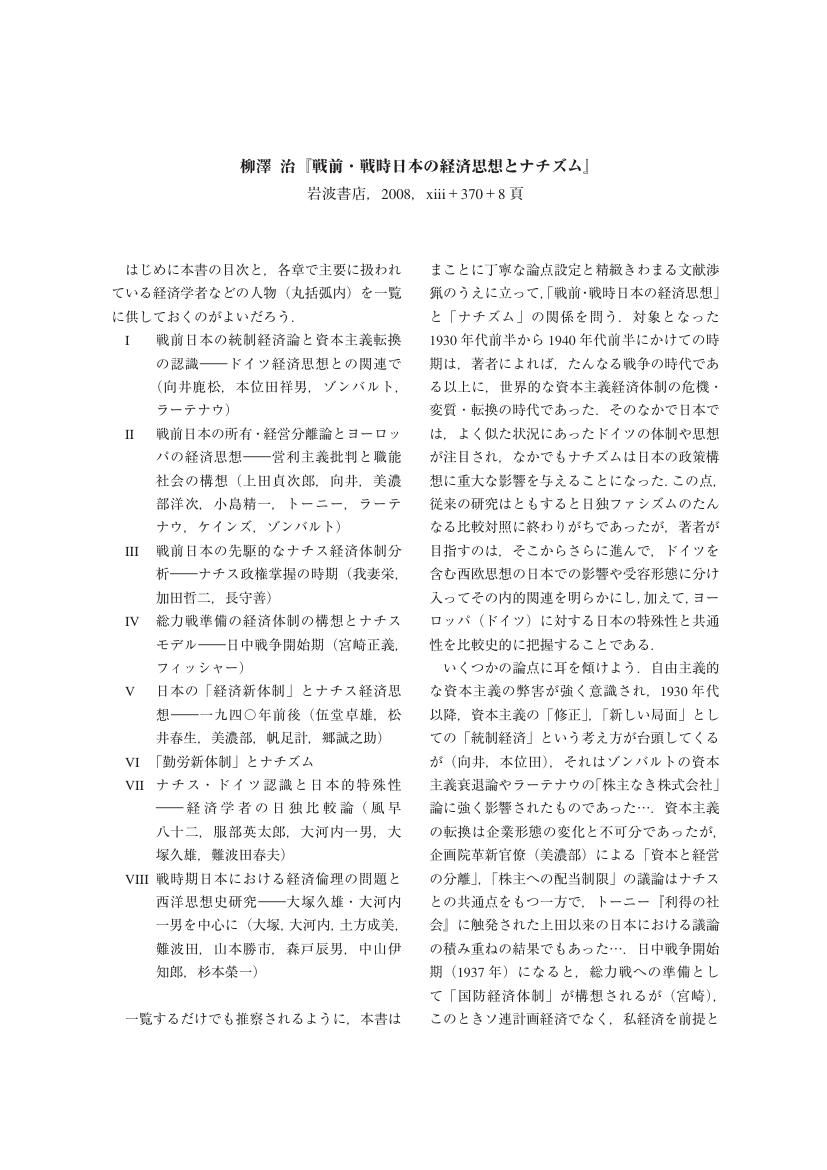1 0 0 0 OA 岩下伸朗『マーシャル経済学研究』 ナカニシヤ出版,2008,xiv+315 頁
- 著者
- 礒川 曠
- 出版者
- 経済学史学会
- 雑誌
- 経済学史研究 (ISSN:18803164)
- 巻号頁・発行日
- vol.51, no.2, pp.108-109, 2009 (Released:2019-08-08)
- 著者
- 下平 裕之
- 出版者
- 経済学史学会
- 雑誌
- 経済学史研究 (ISSN:18803164)
- 巻号頁・発行日
- vol.51, no.2, pp.106-107, 2009 (Released:2019-08-08)
- 著者
- 柳沢 哲哉
- 出版者
- 経済学史学会
- 雑誌
- 経済学史研究 (ISSN:18803164)
- 巻号頁・発行日
- vol.51, no.2, pp.118-119, 2009 (Released:2019-08-08)
1 0 0 0 OA 根岸 隆『経済学の理論と発展』 ミネルヴァ書房,2008,vi+296 頁
- 著者
- 千賀 重義
- 出版者
- 経済学史学会
- 雑誌
- 経済学史研究 (ISSN:18803164)
- 巻号頁・発行日
- vol.51, no.2, pp.120-121, 2009 (Released:2019-08-08)
- 著者
- 太田 仁樹
- 出版者
- 経済学史学会
- 雑誌
- 経済学史研究 (ISSN:18803164)
- 巻号頁・発行日
- vol.51, no.2, pp.102-103, 2009 (Released:2019-08-08)
- 著者
- 髙 哲男
- 出版者
- 経済学史学会
- 雑誌
- 経済学史研究 (ISSN:18803164)
- 巻号頁・発行日
- vol.51, no.2, pp.104-105, 2009 (Released:2019-08-08)
- 被引用文献数
- 1
1 0 0 0 OA 『経済思想』(全11 巻,日本経済評論社,2004―07 年)に学ぶ
- 著者
- 中村 廣治
- 出版者
- 経済学史学会
- 雑誌
- 経済学史研究 (ISSN:18803164)
- 巻号頁・発行日
- vol.51, no.2, pp.94-101, 2009 (Released:2019-08-08)
1 0 0 0 OA Beyond Walras
- 著者
- 塘 茂樹
- 出版者
- The Japanease Society for the History of Economic Thought
- 雑誌
- 経済学史研究 (ISSN:18803164)
- 巻号頁・発行日
- vol.51, no.2, pp.84-93, 2009 (Released:2019-08-08)
- 参考文献数
- 28
1 0 0 0 OA A. マーシャルにおける心理学研究と経済学との連関
- 著者
- 松山 直樹
- 出版者
- 経済学史学会
- 雑誌
- 経済学史研究 (ISSN:18803164)
- 巻号頁・発行日
- vol.51, no.2, pp.51-67, 2009 (Released:2019-08-08)
- 参考文献数
- 59
1 0 0 0 OA カール・ポランニーの「経済社会学」の誕生 『大転換』から『人間の経済』へ
- 著者
- 若森 みどり
- 出版者
- 経済学史学会
- 雑誌
- 経済学史研究 (ISSN:18803164)
- 巻号頁・発行日
- vol.51, no.2, pp.33-50, 2009 (Released:2019-08-08)
- 参考文献数
- 50
- 著者
- 若田部 昌澄
- 出版者
- The Japanease Society for the History of Economic Thought
- 雑誌
- 経済学史研究 (ISSN:18803164)
- 巻号頁・発行日
- vol.51, no.2, pp.18-32, 2009 (Released:2019-08-08)
- 参考文献数
- 49
This paper proposes a way to understand the evolution of macroeconomic thinking. The macroeconomic thinking, not necessarily synonymous with macroeconomics, has been dealing with the questions of money and business cycles. Money and business cycles, in turn, have been closely connected with the international monetary arrangements such as the Gold Standard, the Bimetallic Standard, the Bretton Woods system, and the Flexible Exchange Rate. I shall argue that the evolution of macroeconomic thinking is best understood as the responses of economists to, and their interaction with, the changing monetary and exchange rate regimes. The theoretical foundation of the paper is rather simple: the so-called trilemma, or “irreconcilable or impossible trinity.” A policymaker cannot simultaneously choose a fixed exchange rate, free mobility of capital, and domestic price stability via independent monetary policy. Facing this constraint, the policymaker can, at most, choose two from among these three goals. Therefore, further questions emerge: which goal or goals should be given priority from among these three, and what is the exact tool or mechanism that can ensure the achievement of preset policy goals. The answer to the first question determines the nature of international monetary arrangements, which, in turn, are shaped by political and economic factors. With respect to the second issue, institutions, or what we might call the institutional or social governance technology, play a crucial role. Throughout history, concerns over “unrestrained inflation” have been widespread, since there have always been strong incentives for a government to raise seigniorage by over-issuing money. The choice of international monetary arrangements depends on the availability, credibility, and effectiveness of a specific social governance technology that acts as a constraint upon policymakers, which, in turn, depend on the specific political and economic structure. JEL classification numbers: B 20, B 22, E 42.
- 著者
- 池田 毅
- 出版者
- 経済学史学会
- 雑誌
- 経済学史研究 (ISSN:18803164)
- 巻号頁・発行日
- vol.51, no.1, pp.117-118, 2009 (Released:2019-06-22)
- 著者
- 山田 鋭夫
- 出版者
- 経済学史学会
- 雑誌
- 経済学史研究 (ISSN:18803164)
- 巻号頁・発行日
- vol.51, no.1, pp.119-120, 2009 (Released:2019-06-22)
- 著者
- 塚本 隆夫
- 出版者
- 経済学史学会
- 雑誌
- 経済学史研究 (ISSN:18803164)
- 巻号頁・発行日
- vol.51, no.1, pp.113-114, 2009 (Released:2019-06-22)
- 著者
- 服部 正治
- 出版者
- 経済学史学会
- 雑誌
- 経済学史研究 (ISSN:18803164)
- 巻号頁・発行日
- vol.51, no.1, pp.111-112, 2009 (Released:2019-06-22)
- 著者
- 田中 秀夫
- 出版者
- 経済学史学会
- 雑誌
- 経済学史研究 (ISSN:18803164)
- 巻号頁・発行日
- vol.51, no.1, pp.109-110, 2009 (Released:2019-06-22)
- 著者
- 小林 純
- 出版者
- 経済学史学会
- 雑誌
- 経済学史研究 (ISSN:18803164)
- 巻号頁・発行日
- vol.51, no.1, pp.107-108, 2009 (Released:2019-06-22)
1 0 0 0 OA Polish Economics and the Polish Economy
- 著者
- Marek Ratajczak
- 出版者
- The Japanease Society for the History of Economic Thought
- 雑誌
- 経済学史研究 (ISSN:18803164)
- 巻号頁・発行日
- vol.51, no.2, pp.1-17, 2009 (Released:2019-08-08)
- 参考文献数
- 27
- 被引用文献数
- 1
The anniversary of the launch of transition in Poland is a good opportunity for summarizing the changes that have occurred in Polish economics and the Polish economy over the last twenty years. The author believes that certain processes cannot be understood without providing a broader historical background to them. Therefore, the aim of this paper is to present what the author believes to be the most important trends in the development of the Polish economy and Polish economics not only in the postwar period, but also before World War II. Polish economics and the Polish economy have undergone transformation over two decades of transition. In this period, Polish economists began to adapt their research to major trends of modern economics. A majority of them agreed to the concepts of mainstream economics. The main weakness of Polish economics continues to be the limited number of publications in prestigious English-language periodicals. In effect, Polish economics continues to be little known in the world. JEL classification numbers: B 24, N 14, P 30.
1 0 0 0 OA 中村隆之『ハロッドの思想と動態経済学』 日本評論社,2008,xiii+238 頁
- 著者
- 井上 義朗
- 出版者
- 経済学史学会
- 雑誌
- 経済学史研究 (ISSN:18803164)
- 巻号頁・発行日
- vol.51, no.1, pp.115-116, 2009 (Released:2019-06-22)
1 0 0 0 OA F. ラヴィントンにおける企業家の役割 理論構築,現状認識,および規範的な行動基準
- 著者
- 小峯 敦
- 出版者
- 経済学史学会
- 雑誌
- 経済学史研究 (ISSN:18803164)
- 巻号頁・発行日
- vol.51, no.1, pp.60-75, 2009 (Released:2019-06-21)
- 参考文献数
- 50
Frederic Lavington (1881–1927) played a significant role as a node between Marshall’s and Keynes’s eras. While Marshall trusted on the individual chivalrous entrepreneur, Keynes no longer depended on such an individual and placed his hopes on semi-autonomous bodies guided by public authorities. Although Lavington was a devotedly orthodox Marshallian, he was also a revolutionary theory developer, and he was located in the transition period between the two important figures. He recognised an inherent instability in the modern economies of the time but still held an optimistic view of capitalism. Lavington relied on able entrepreneurs as a group, who he believed could eliminate the contradictions between individual rational calculations and collective disturbing consequences. Lavington’s insight on capitalism can be understood as a threefold-layer structure, at the core of which is an entrepreneur. This structure comprises the following: (1) theory construction, related to revolutionary devices such as liquidity preference and portfolio selection, (2) contemporary recognition, related to the trade cycle and (3) normative behavour, related to leaders in industry. The first is concerned with rational behaviour under uncertainty; the second, with unexpected disturbances and the third, with a coordination problem: if the captains of industry work well in business organizations, the gap between the micro- and macro-layers tends to reduce. Although he was very close to Keynes in the light of points (1) and (2), Lavington shared almost the same view of Marshall in the light of point (3). This duality had made evaluations on him extremely difficult. JEL Classification: B10, B31, L16
















